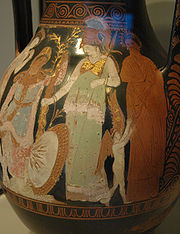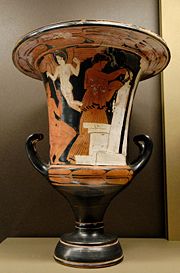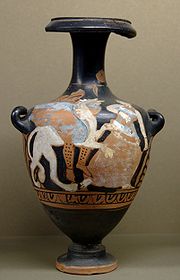
Kerch Style
Encyclopedia


The Kerch style is an archaeological term describing vases from the final phase of Attic
Attica
Attica is a historical region of Greece, containing Athens, the current capital of Greece. The historical region is centered on the Attic peninsula, which projects into the Aegean Sea...
red-figure pottery
Red-figure pottery
Red-figure vase painting is one of the most important styles of figural Greek vase painting. It developed in Athens around 530 BC and remained in use until the late 3rd century BC. It replaced the previously dominant style of Black-figure vase painting within a few decades...
production. Their exact chronology remains problematic, but they are generally assumed to have been produced roughly between 375 and 330/20 BC. The style is characterized by slender mannered figures and a polychromatism given to it by the use of white paint and gilding.
The vases are thus named because a large quantity of them were found at Kerch
Kerch
Kerch is a city on the Kerch Peninsula of eastern Crimea, an important industrial, transport and tourist centre of Ukraine. Kerch, founded 2600 years ago, is considered as one of the most ancient cities in Ukraine.-Ancient times:...
(ancient Pantikapaion
Panticapaeum
Panticapaeum , present-day Kerch: an important city and port in Taurica , situated on a hill Panticapaeum (Greek: Παντικάπαιον, Pantikápaion), present-day Kerch: an important city and port in Taurica (Tauric Chersonese), situated on a hill Panticapaeum (Greek: Παντικάπαιον, Pantikápaion),...
) on the Black Sea
Black Sea
The Black Sea is bounded by Europe, Anatolia and the Caucasus and is ultimately connected to the Atlantic Ocean via the Mediterranean and the Aegean seas and various straits. The Bosphorus strait connects it to the Sea of Marmara, and the strait of the Dardanelles connects that sea to the Aegean...
. The majority of these are now in the Eremitage
Hermitage Museum
The State Hermitage is a museum of art and culture in Saint Petersburg, Russia. One of the largest and oldest museums of the world, it was founded in 1764 by Catherine the Great and has been opened to the public since 1852. Its collections, of which only a small part is on permanent display,...
, St. Petersburg. It is not possible to set formal criteria which separate them stylistically from the contemporary plain style of late classical
Classical Greece
Classical Greece was a 200 year period in Greek culture lasting from the 5th through 4th centuries BC. This classical period had a powerful influence on the Roman Empire and greatly influenced the foundation of Western civilizations. Much of modern Western politics, artistic thought, such as...
vase painting around painters like the Jena Painter
Jena Painter
The Jena Painter was an ancient Greek vase painter, active in Athens around 400 BC. He mainly painted kylikes in the red-figure technique. His stylistic and chronological place was first determined by the British Classical archaeologist, John D. Beazley...
or the Meleager Painter
Meleager Painter
The Meleager Painter was an ancient Greek vase painter of the Attic red-figure tradition. He was active in the first third of the 4th century BC. The Meleager Painter followed a tradition started by a group of slightly earlier artists, such as the Mikion Painter. He is probably the most important...
. The end of the Kerch style coincides with the end of red-figure painting as a whole. The identification of individual painters is often difficult.
At the time of their production, Kerch style vases were exported to all of the Mediterranean region, but unlike earlier phases, the Black Sea area was the main market for this late phase of Attic pottery export. Most of the previously current vase shapes were still painted, but krater
Krater
A krater was a large vase used to mix wine and water in Ancient Greece.-Form and function:...
s, lekanes (see Typology of Greek Vase Shapes
Typology of Greek Vase Shapes
Pottery in Greece has a long history and the form of Greek Vase Shapes has had a continuous evolution from the Minoan period down to the Hellenistic era...
) and pelike
Pelike
A pelike is a one-piece ceramic container similar to an amphora.It has two open handles that are vertical on their lateral aspects and even at the side with the edge of the belly, a narrow neck, a flanged mouth, and a sagging, almost spherical belly....
s were especially popular. The motifs are mostly scenes from the life of women (often exaggeratedly idyllic), dionysiac themes and subjects to do with Artemis
Artemis
Artemis was one of the most widely venerated of the Ancient Greek deities. Her Roman equivalent is Diana. Some scholars believe that the name and indeed the goddess herself was originally pre-Greek. Homer refers to her as Artemis Agrotera, Potnia Theron: "Artemis of the wildland, Mistress of Animals"...
and Demeter
Demeter
In Greek mythology, Demeter is the goddess of the harvest, who presided over grains, the fertility of the earth, and the seasons . Her common surnames are Sito as the giver of food or corn/grain and Thesmophoros as a mark of the civilized existence of agricultural society...
. Fighting griffins are another common subject. The figures are often elegant and highly decorated. But they are very stylised and frequently seem quite mannerist. Details and ornamentation played an important role, the best works resemble examples from the fifth century BC. White, yellow and red were often used as additional colours. The casual painting of the backs of vases is another typical feature.


Marsyas Painter
The Marsyas Painter was an ancient Greek vase painter of the red-figure style. He was active in Attica between 370 and 340/330 BC. The Marsyas Painter is sometimes considered the best of the Attic red-figure painters of the late 4th-century Kerch Style. His conventional name is derived from the...
, the Eleusinian Painter and the Painter of Athens 12592 mark a short and final flourish in the quality of Attic vase painting. Shortly afterwards, the activities of the YZ Group
YZ Group
The YZ Group is an assumed group of ancient Greek Attic vase painters of the red-figure style.Individual artists can only be identified with difficulty. The group was given its conventional name by John D. Beazley during his studies of Attic red-figure was painting. He named the group "YZ" because...
painters produced a multitude of vases of inferior quality in a number of workshops. Their end is also that of the Attic red-figure tradition. Recent research has thrown new light on this long-neglected field. The vases were first studied systematically by Karl Schefold
Karl Schefold
Karl Schefold was a classical archaeologist based in Basel, Switzerland. Born and educated in Germany, he was forced in 1935 to emigrate to Switzerland, which he adopted as his home country...
. The most important scholar of Attic vase painting, John D. Beazley
John Beazley
Sir John Davidson Beazley was an English classical scholar.Born in Glasgow, Scotland, Beazley attended Balliol College, Oxford, where he was a close friend of the poet James Elroy Flecker. After graduating in 1907, Beazley was a student and tutor in Classics at Christ Church, and in 1925 he...
, only developed an interest in them late in his career; he did not agree with all of Schefold's views. In recent years, the analysis of fourth-century BC Panathenaic amphorae
Panathenaic Amphorae
Panathenaic amphorae were the large ceramic vessels that contained the oil given as prizes in the Panathenaic Games...
from Eretria
Eretria
Erétria was a polis in Ancient Greece, located on the western coast of the island of Euboea, south of Chalcis, facing the coast of Attica across the narrow Euboean Gulf. Eretria was an important Greek polis in the 6th/5th century BC. However, it lost its importance already in antiquity...
has provided new results. Additionally, it has been demonstrated that Kerch style vases were also produced outside Attica, for example in Chalkidiki. Generally, the South Italian
South Italian
South Italian is a designation for ancient Greek pottery fabricated in Magna Graecia largely during the 4th century BC. The fact that Greek Southern Italy produced its own red figure pottery as early as the end of the 5th century BC. was first established by Adolf Furtwaengler in 1893...
red-figure vase production of the time was superior to the Attic Kerch Style. The South Italian production also continued somewhat longer.
Representatives of the style include:
- Amazon Painter
- Apollonia Group
- Painter of Athens 1375
- Erotostasia Painter
- F.B. Group
- Filottrano Painter
- Group G
- Helena Painter
- Herakles Painter
- L.C.-Group
- Group of London E 230
- Otchet Group
- Pasithea Painter
- Pompe Painter
- Pourtales Painter
- Toya-Painter
- Painter of the Wedding Procession

